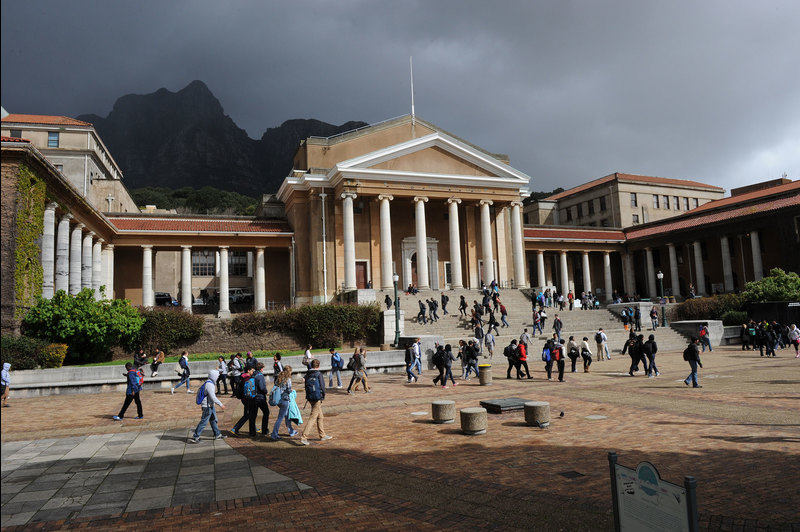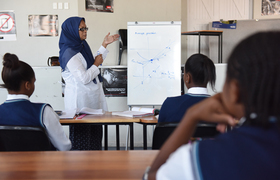Inequality in higher education mushroomed by COVID-19 pandemic
04 October 2023 | Story Niémah Davids. Photo UCT News. Read time 10 min.
It has been almost four years since the COVID-19 pandemic wreaked havoc in the world and many are still trying to pick up the pieces. It’s apt to say that in South Africa it deepened the divide between the haves and haves-not, and exacerbated a myriad of challenges millions in the country have struggled to overcome for years.
This global health crisis affected most sectors of society. Operations were brought to a grinding halt, which, in many instances, led to widespread job cuts. Schools and universities were shut down and in the higher education space, online teaching and learning was introduced as a matter of urgency so that students could navigate their academic programmes with ease. But for those students living in campus residences, this approach was far from ideal. Returning home, often to the most rural parts of the country with limited physical resources and scrappy internet connectivity, spelt disaster.
In August 2020, during the height of the pandemic, researchers in the Siyaphambili (We are moving forward.) Project, an initiative of the Southern Africa Labour and Development Research Unit (SALDRU) at the University of Cape Town (UCT), set out to answer several pertinent questions. These related to student retention at university level in 2020 and academic performance in 2020 and 2021. The project was titled: “The COVID-19 health crisis and inequalities in tertiary education in South Africa”.
“COVID-19 saw system-wide closures of institutions, prompting concerns that existing households and institutional inequalities could deepen during this period.”
“COVID-19 saw system-wide closures of institutions, prompting concerns that existing household and institutional inequalities could deepen during this period. Typically, on-campus learning and living presents a way – albeit imperfect – of equalising access to resources for students from various backgrounds. This was not possible during remote teaching and learning. Therefore, existing household inequalities are likely to have further disadvantaged students during this time,” said Dr Emma Whitelaw, a postdoctoral research fellow on the Siyaphambili Project.
UCT News recently sat down with Dr Whitelaw and Associate Professor Nicola Branson, the project’s principal investigator, for more on this project, its findings and what they mean for tertiary education in South Africa.
Niémah Davids (ND): What was your goal with this research project?
Emma Whitelaw (EW): It’s important to note that while the COVID-19 pandemic affected all levels of education, our research focused on post-school education. What we wanted to do was to provide empirical evidence on student performance and retention for the years 2020 and 2021. The aim was to use our findings to guide higher education institutions and government as they work towards developing strategies to address the consequences of the pandemic, which we know will persist over the next couple of years.
Our project was funded by the Spencer Foundation – a leading organisation based in the United States (US) that focuses on education research that aims to cultivate learning and transform lives. We are very proud of this project because it was the only one funded outside of the US.
ND: Why was this work so important?
Nicola Branson (NB): In South Africa, completing a higher education qualification improves job prospects and increases earning, providing the potential to vastly improve students’ and their families’ socioeconomic circumstances. However, stark disparities in access to higher education and completion exist, and these are strongly linked to much broader social inequalities.
ND: Before we get into your findings, talk to us about your data collection process.
EW: Our project drew on administrative data from the Higher Education Management Information System (HEMIS) on students enrolled in all public universities in South Africa between 2015 and 2020. And we supplemented this data with student-level enrolment and application data from UCT. Under the Siyaphambili Project, we have access to and ethics approval for using anonymised data in this way.
ND: What do your findings indicate about student retention at higher education institutions during this period?
NB: We used system-wide institutional data that revealed that undergraduate student retention decreased by up to 25% at public universities in South Africa – depending on year of study and institution type – for the period under review. Students in higher academic years were most impacted, with students in their second year of study showing similar dropout rates when compared to previous cohorts.
“It’s also important to note that each institution responded differently to the pandemic.”
For example, our research found that students who entered their third year of study at the University of Fort Hare in 2020 were 7% more likely to drop out when compared to students entering their third year prior to 2020. This demonstrates a larger than twofold increase in dropout rates compared to previous years. Holistically, we observed large increases in dropout rates at historically disadvantaged universities, merger and new institutions in 2020. Within institutions, we also compared retention changes in 2020 among students funded by the National Student Financial Aid Scheme (NSFAS). We found that NSFAS students were less likely to drop out of their studies when compared to their unfunded peers. In fact, in institutions where dropout levels ballooned for the period, unfunded students were mainly affected. This suggests that funded students may have used NSFAS funds to provide important financial and social support for their families during the pandemic.
This said, it’s also important to note that each institution responded differently to the pandemic. Those responses and the institution’s social context would also have played an important role in determining student retention and performance outcomes during the pandemic.
ND: Now, please unpack what your research revealed on overall student performance.
EW: In our research, which made use of UCT institutional data, we demonstrate that improvements in academic performance in 2020 did not reflect true learning gains. At UCT, performance made during the height of the pandemic (in 2020) were reversed in 2021, widening achievement gaps between students from different socioeconomic backgrounds. But we cannot attribute these changes to a single mechanism. Our findings suggest that marked improvements in 2020 were likely influenced by factors such as reduced volumes of learning content; marker leniency; and reduced credit loads, rather than changes to assessments or online learning. This is because the 2021 academic year proceeded online too.
What we’ve also noted is that, on average, students who matriculated in 2020 and started their studies in 2021, tended to have a lower grade point average, compared to students who started their studies in 2021 but matriculated before 2020. This could suggest learning loss at matric level in 2020.
ND: What are you hoping government, policy makers, civil society and the public will take away from this research?
EW: What’s significant is that NSFAS funding likely offered important social security, especially during a time of crisis, which opens a whole different conversation on the number of people who are living below the bread line in our country and the best ways to support them.
NB: In addition to that, I’d say that government, policy makers and institutions need to pay careful attention to that widening achievement gap and our evidence on potential learning loss among final-year high school learners. These findings, in particular, highlight the need to address those disparities by putting measures in place to ensure that we avoid instances that deepen inequality. Key stakeholders should also be aware of the interplay between student retention and funding and how these dynamics shape institutional planning across the sector.
ND: Will the sector be able to make a comeback?
NB: Our research cannot answer this question yet, at least not with the data that we have available. The answer would also depend on which dimension one is looking. For example, a more thorough investigation of graduate employability over this time will be required to ascertain whether or not the COVID-19 cohorts of graduates face different employment outcomes. We also need to recognise that the sector will continuously be shaped by the students coming into it, who will have experienced differential learning during the pandemic in secondary school.
“The pandemic has provided a space for innovation in teaching and learning, and teaching models may affect how efficiently the sector supports vulnerable students going forward.”
EW: That said, the pandemic has provided a space for innovation in teaching and learning, and teaching models may affect how efficiently the sector supports vulnerable students going forward. Ultimately, our project aimed to shed light on the intricate interplay between a global health crisis, education and inequality. We hope that insights from this work will continue to spark meaningful dialogue and informed action towards creating a more equitable higher education landscape in South Africa. We should also mention that we are incredibly grateful to all those who gave their time, knowledge, and efforts to this work.
 This work is licensed under a Creative Commons Attribution-NoDerivatives 4.0 International License.
This work is licensed under a Creative Commons Attribution-NoDerivatives 4.0 International License.
Please view the republishing articles page for more information.










